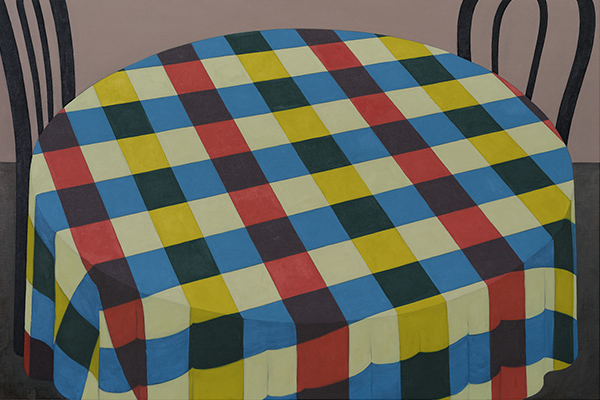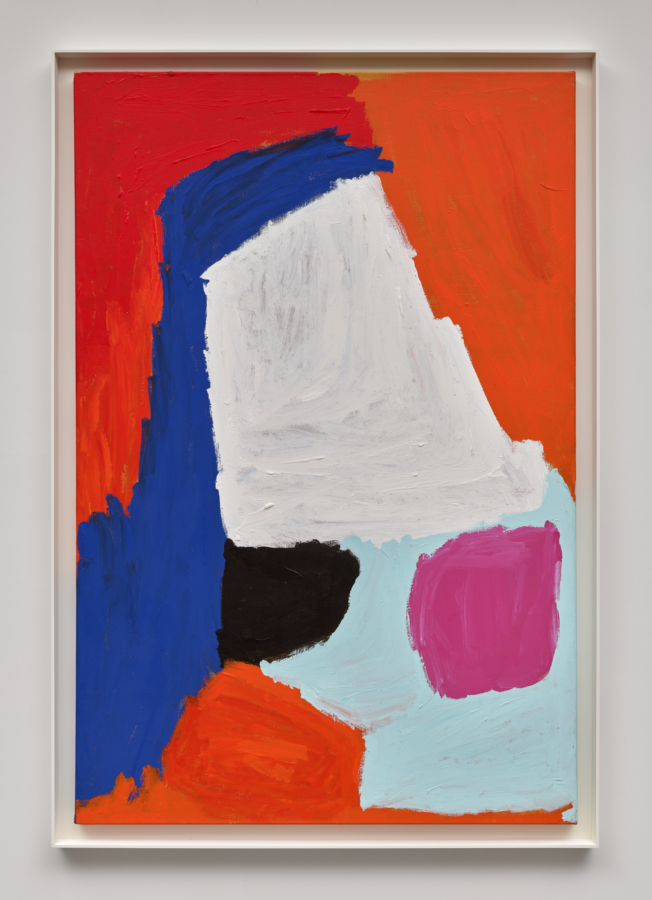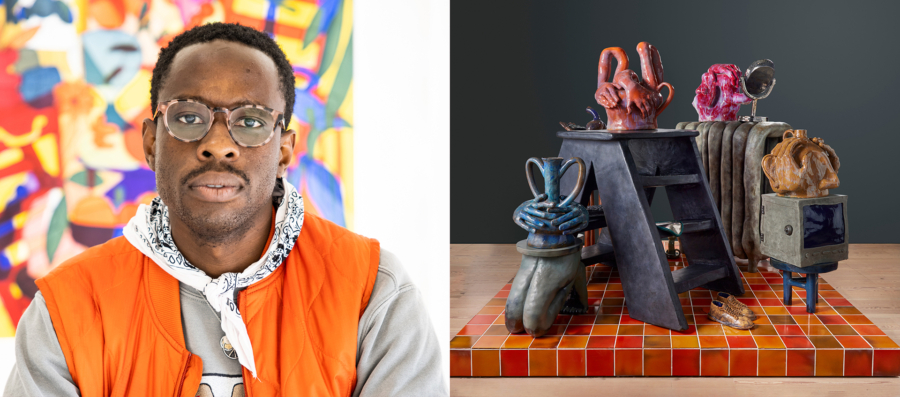July 2021
Lee Lozano: Drawings 1958-64 published by Karma, New York, 2021
A work on paper by Lee Lozano dated 1963 plays with drawing “dirty.” In it the truncated torso of a man clutches a magazine, held greedily by tumescent fingers to his chest. The “girly” rag he holds is identified as Playboy, both by its title and its display of naked female body parts. Erect nipples surmount mounds and spheres, curvaceous bottoms and breasts rhyme and touch, a plethora of women’s bits and bobs adorn the front and back of this spread-out, jam-packed cover in an excessive, almost parodic display. The joke, it seems, is on the reader. For while his face is buried in bliss, his penis is doubled up with glee. Blushing and erect, his member, which extends improbably beyond his belly button, has mysteriously doubled so that it resembles a pair of fleshy, pink rabbit ears that wave anticlimactically over his groin. As much playgirl, it seems, as playboy, the eager consumer is transformed here into the commodified “bunny girl” beloved of the magazine’s owner and identified as part of his “brand.” The duplication of his penis, instead of amplifying the reader’s virility, therefore, appears to render it limp, his swollen perkiness made to seem as ridiculous as the costume of a flossy-tailed hostess. Far from appearing virile and strong, the reader appears as the commodified object of his own fantasy, locking him in a solipsistic and masturbatory world, made real in the glossy language of porn. In this punning, irreverent parody, sex appears with all of its trappings: trussed up as fetish or display, coded as image or text, organized along binary lines. “Man” and “woman” emerge, in pieces, from the sexualized languages and conduits of exchange of which culture and commerce are made.
To draw “dirty,” then, is not only to draw on the vocabulary of the bawdy and vulgar: the tits and cunts and cocks and balls of which locker-room humor is made. It’s also to sully the elevated pretensions and refinements of Art with an energy that comes from the hand. Clasping a tool or a dick, holding a gun or a crayon, the hand is both the agent of pleasure and manual manipulator that turns the page into an orgy of onanistic and ornamental design. Its fat, phallic fingers grasp greedily onto tubular weapons and props, analogues for the pencils and penises that seem, in Lozano’s masculinist vocabulary, to signify creativity, curiosity, and craft. Art, like life, is handmade; it is coaxed and caressed into being. Thematized by the grip and the grasp of a clenched fist or the open, splayed fecundity of an outstretched palm, drawing, for Lozano, could charm and stroke, attack and accost, shape and conjure a world. It is neither polite nor palliative.
By the time she came to sketch out her double-dicked avatar, Lozano had been using pencil, wax crayon, and pastel to attack the protocols and pretensions of refined draftsmanship for some years. Having been trained at the Art Institute of Chicago, done a stint in a commercial design studio, and traveled Europe looking at art and imbibing Expressionist and gestural styles, she had settled, in 1960, in New York, hanging out with a cohort of rebellious male artists susceptible to machismo and the material obduracy of things. While still an art student in Chicago, Lozano had showed herself to be highly skilled in drawing and design. School exercises involved inhabiting various modes of picture making and marking. She proved herself agile at reinventing Indian miniatures, Egyptian wall paintings, or pre-Columbian reliefs. Painting and drawing in gouache on paper, she demonstrated her capacity for linear elegance, controlled color harmonies, balanced composition and pattern, tonal gradation, and illusionistic design. In the New York of the early ’60s, though, she turned her back on these proven competencies and skills. In the company of her newfound friends, Lozano gravitated instead to the traditional vocabulary of men’s work and play, seeking out the rough, proletarian pleasures of drilling, hammering, screwing, and swearing in a bold faux-comic-book style, graffitied and grafted on the page. Now colors and shapes appear crude. Figures emerge cartoonlike in simplified, synoptic form. Lines, though sometimes elegant, can be corralled into the obscene and the ordinary, or made to appear like furious, repetitive scratches designed to conceal as much as describe. Writing and drawing collide, each pushed to the service of the other, so that words in borrowed scripts and pregnant phrases sit alongside swollen body parts and gaping holes like dysfunctional quotations and quips. The humor and wit are bawdy, mirrored by the vigor, variety, and strength of the mark-making, and a refusal of polish or taste. It’s a transgressive and iconoclastic fest: anti-skill, antisocial, antithetical, a “manly,” macho display, figured in the touch and tone as much as in the innuendos and imagery.
It was not to women that Lozano turned, either for companionship, sensibility, or solidarity. Though her phallic fantasia— metonymically figured in toy airplanes, long noses, tubes, tools, and guns—had much in common with the deflationary aesthetics of some of her female peers, including Yayoi Kusama, Eva Hesse, and Louise Bourgeois, for whom the literal transcription and proliferation of penises formed part of a desublimatory (perhaps feminist) urge, Lozano favored the ribald humor and rebellious defiance of common speech and everyday smut, despite its misogynist bent. There was nothing elemental or archetypal about the orifices and protuberances of her mind. They register in her work as crude body parts, borrowed from mass culture and the everyday scribblings of adolescent men and youths bent on being funny and rude. Alongside the pricks and the poles, sharp-toothed vaginas, spewing arseholes, sockets, and plugs appear in this pornographic panoply. It’s as if Lozano is longing to play with the boys and must better them at their own game.
Given the possibilities for women in the New York of the 1960s, this had a certain logic and force. Like Gertrude Stein half a century before her, Lozano knew that virility and creativity were customarily aligned and that an identificatory association with “genius” meant an eschewal of the feminine vectors through which artistic power was expressed. When Stein saw Picasso’s Demoiselles d’Avignon in his studio in 1907 or 1908, she did not identify with his primitivized and sexualized female cyphers, those mask-faced harridans culled from the space/time of European fantasy and myth. Rather it was the male energy and experimental libido of the artist that she saw as akin to her own. Transgressing sexual and social norms required stepping outside of her assigned gender role in order to unleash a potency and ambition associated historically with men. Lozano did much the same. But her experimentation in the early ’60s with form and genre reproduced the heteronormative terms of engagement of which popular culture (and most art) was made. It was only through drawing “like a man” that Lozano felt able to escape the stifling mediocrity of the milieu in which women were routinely confined.
One need look no further than the Hollywood movie Dirty Dancing, set in a resort in the Catskills in 1963, for a model of the suburban stultification against which Lozano rebelled. Telling the story of seventeen-year-old, Jewish “Baby” (her name alone indicates the arrested development and perpetual infancy to which women were customarily confined), who experiences a sexual awakening in the arms of her dance instructor, Jonny, Dirty Dancing offers a retrospective take (the film was made in 1987) on the ethnic exclusivism and double standards of middle-class American life. Separated by class and culture, but aroused and drawn to one another through the “dirty” dancing lessons for which Baby’s father pays, the film charts the sexual/moral awakening of the heroine, who, over the course of a steamy summer, turns from a docile somnambulist into an adult capable of desire and dance. Sex and creativity are intertwined here, and it is only by breaking out of the frigid constraints of her upbringing that Baby can become self-actualized and free.
With its feel-good ending and dollops of Hollywood schmaltz, there is little in common between Dirty Dancing’s melodic capacity to resolve difficulty and Lozano’s cacophonous and risky course. And yet, the film offers a representation of much that Lozano refused in her experimental and iconoclastic early work. Alongside gender norms and sexual mores, family values and petty concerns (the annual beachwear contest offers an unmatched opportunity to think about bathing beauties as a patriarchal plot), the film’s parochial world of East Coast Jewishness, with its in-house jokes, snobbery, and stultifying upward mobility, provides a picture of everything that Lozano eschewed. Flying in the face of her upbringing, she reveled in appropriating its symbols in an almost sacrilegious, satirical vein. The Star of David makes multiple appearances in her drawings, not so much as a token of affiliation or belonging, but rather as a subversive signifier appropriated for scatological and scandalous abuse. Appearing once as a cock-ring hugging a circumcized schlong, it resurfaces, in duplicate, as a medallion settled on a young girl’s chest, or adorning the side of a tuna can over which are emblazoned the words “kosher for passed away.” Referencing Passover culinary laws and the authorities who police its rule, the words and the Jewish star reference the kosher dead fish in the can at the same time as intimating the deathly aura that hangs over this commercialized trade. And the Magen David adorning the label finds its place on the tail of the tuna, inscribing its penile shape with an ethnic signifier that speaks to the practice of assigning this or that flesh or body part with a stamp/cut of approval that is institutionally (and commercially) enshrined.
This takes us back to the proliferation of penises that populate Lozano’s early pictorial world. That they come as both literal organs and phallic totems is by now abundantly clear. Entering crevices and cracks, from vaginal slot machines to toothy mouths and hairy butts, they appear too as blunt tools, facial protuberances, cigars, fingers, or guns. But most obviously and literally they star as shaped and acculturated body parts, sometimes ejaculating, usually erect, occasionally flaccid or bent out of sorts. “Let them eat cock” scrawls Lozano in a mockingly aristocratic decree, as if pointing to the class-bound play of the poor, for whom sex, unlike cake, is within grasp. It’s a ribald, desublimated world, figured and fingered in a riot of conjured crudity and filth.
The Playboy/Playbunny drawing represents the apogee and the climax of such hyperbolic and hedonistic work. Here the work of sex and the work of art are juxtaposed. While the synechdochic body parts of the cover girls stand in for their labor and lives, the over-endowed excess of the reader speaks both to his lust and his lies, for the overstatement and pink excitement of the headless man render him at once virile and weak, vulnerable to performance anxiety and a fear of the feminine to boot. That he doubles up, as we have seen, as the figuration of the femininity he disavows, is the brilliant, ironic point of the piece. Lozano’s energy-filled lines and simplified drawing, her lettering and crude colouring-in, eschew all refinement and delicacy of touch, whether in relation to sex or art. Drawing “dirty” batters the body into view. It’s a bold and bawdy affair, far from the passivity and repression assigned to women of the time and far from the artistic competence in which she had been schooled. For three or four years, Lozano used her tools to thematize a worldview that refused the delimitation of gender for the celebratory power of sex. It required all her artistic skill to manufacture such a convincing display of its apparent energy and generative exuberance.
But by late 1963, Lozano had begun to tire of the double entendres and Guston-like forays into the mediated excesses of the everyday. She had milked de Kooning’s smile to death, she had played with Pop’s pragmatism and porn, she had drawn on comics and caricature to create her own personal rejoinder to the world of sperm-spreading fighter planes and man-devouring genitalia and teeth. For a time, she hung on to the world of tools, but then she increasingly called a spade a spade and the slippages and symbolic overload of her ambiguous and sexually saturated nails and screws gradually gave way to the obdurate veracity and facticity of a volumetric wrench or a shaded clamp, now meant to signify just that. Closely linked to Carl Andre in the early ’60s, Lozano shared his passion for readymades and rough materials, often sourced on New York’s streets. She, like Andre, loved the shape of things, especially things associated with building, industry, and the materiality of everyday life. The famous Hollis Frampton photographs of her studio and worktable at this time provide a veritable inventory of metallic bolts and pipes and screws, each like an abstract sculpture, symmetrical, smooth, and sleek. For Lozano, the beauty of these functional objects now transcended their obvious priapic analogues and puns. Instead, they became the focus for a meditation on the materiality of the industrialized world and the capacity of paint and pencil to approximate its density and weight. Nevertheless, the erotic undertones, brute aggression, and black humor of Lozano’s oversize implements cannot help but render them anthropomorphized. Even when a spade appears resolutely as a spade, it doubles up, defiantly as a body.
In a series of giant paintings and ambitious drawings, executed between 1963 and 1966, Lozano harnessed her training and skill to explore the physical properties and formal harmonies of man-made tools and gear. At the moment of transition to this regenerated realism, built on a materialist appreciation for “honest” labor (especially that associated with men) as well as an identification with the physical act of making anew, Lozano could not resist a pun. A Boring Drawing (1963) evidences her paradoxical fascination with the mechanical inner workings of a drill while playing with the potential of this ordinary object to be both useful and dull. Here, inscribed text still provides the clue to her witty play with image and form. But the obscene humor and sexual innuendo, as well as the faux freedom, of the “dirty” drawings are all but gone. In the coming years, in clean-cut lines and controlled gradations of tone, Lozano would map out the page/canvas so that magnified tools and mechanical parts appear like gigantic monuments and shapes. These are often planned on graph paper accompanied with measurements, calculations, and notes. Their orientation and slant, their contour and cut, their variety and range: each is tried and tested in a series of works that no longer appear like reworked scribbles or expressive outpourings, but as builder’s or architects’ plans—sober, cerebral, and neat. It’s as if the energy of the hand, so thematized in the earlier work by the purloined languages of masturbatory fantasy and obscenity, is now transformed into a sober reflection on the mechanics and machinations of the “real.” For Lozano, drawing was always a matter of mediation. But now her manual, “manly” skill is marshaled to the material world and to the tools from which it is forged.



